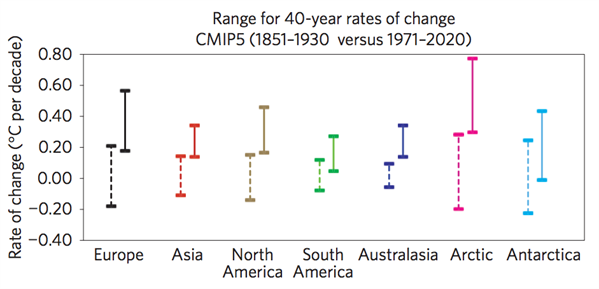Near Future
The heat is on
-Gloria Gaynor
Faster, faster, faster
-Talking Heads (Air)
Greetings
One problem with the climate change story, is that the studies tend to focus on what is likely to happen sometime in the future, say, 2010. And what is likely to happen , on average around the world. So many degrees by 2100 on average, doesn't really tell people what they want to know. And it doesn't really inspire people to take action.
Happily, a resent study brings things into better focus. The paper "Near-term acceleration in the rate of temperature change.", helps to bridge that gap. The authors break down the the time line into 40 year segments, and break out the world into regions. They find that for many regions, including North America, the increases in temperature are likely to grow at a faster rate than we are already experiencing. These results are based on the IPCC models, and do not incorporate feedback mechanisms.
Listen to an interview with one of the authors, Dr Stephan Smith , here. He explains that North America is likely to warm more than the average, because is so large, and so less of the continent is buffered by the ocean. "In North America, the models showed a change from about .7 to about 1.8 degrees Centigrade over a 40 year period.... that's about 1 to 3 degrees Fahrenheit over that period."
Carbonbrief .org has a good explanation of the study including this::
--------
"Rate of temperature change
The researchers analysed changes in temperature over 40-year periods, looking at how quickly the temperature rises from one decade to the next. By using 40-year periods, the researchers smooth out the year-to-year ups and downs in order to focus on the influence of human-caused climate change only.
By analysing past temperature records, the researchers found that for the 900 years before the 20th century, rarely any 40-year periods show warming of more than 0.1 degrees per decade.
But when they looked at the second half of the 20th century, the speed of temperature changes increased. Their analysis shows the rate of surface temperature rise in the Northern Hemisphere is now over 0.2 degrees per decade.
Projected trends
The researchers also look at rates of change for the present and near future. Using climate models, they calculated rates of decadal temperature changes for 1971-2020. They then compared them to 1851-1930, before substantial human-caused warming occurred.
The projections are based on an Intergovernmental Panel on Climate Change (IPCC) scenario where global action is taken to limit greenhouse gas emissions. This means it assumes countries around the world will cut back on carbon emissions very quickly, which currently isn't the case.
The graph below shows the results for each region of the world. Each bar shows the range in results from the climate models, with the solid lines showing 1971-2020 data and the dashed lines showing 1851-1930.
You can see the rates of change are projected to increase for all regions, with the Arctic standing out above the others. Temperatures in the Arctic are currently rising twice as fast as the global average. As Arctic sea-ice diminishes, energy from the sun that would have been reflected away by sea-ice is instead absorbed by the ocean, a phenomenon scientists call Arctic amplification.
Range of past (1851-1930, dashed lines) and near-future (1971-2020, solid lines) regional rates of surface temperature change per decade. Bars show the range of climate model results, based on emission scenario RCP4.5. Source: Smith et al. (2015)
Projections for the rest of the century show average rates of temperature change per decade could reach around 0.4 degrees in Europe and North America, and 0.6 degrees in the Arctic.
But as these results are from a scenario of limited greenhouse gas emissions, the rates could get even higher."
Labels: 40 years, accelerating climate change, ecoshock, Stephan Smith


0 Comments:
Post a Comment
Subscribe to Post Comments [Atom]
<< Home